As the Independence Day, August 14, comes nearer national flags can be seen — hoisted on the government and private buildings, houses, markets, cars, trucks and motorcycles.
Every Pakistani is aware what the flag of our country, adopted during a meeting of Constituent Assembly on August 14, 1947, symbolises. The white and dark green fields represent minorities and Muslims respectively. The crescent on the flag represents progress whereas the five-rayed star represents light and knowledge. What is depressing to see is that sixty seven years on we are still struggling to live up to what our national flag truly symbolises.
The size of the white portion on flag is one-fourth of its size and it was an accurate depiction of Pakistan at the time of partition in 1947 – almost 23 per cent of country’s population was comprised of non-Muslim citizens. Today, the proportion of non-Muslims has declined to approximately 3 per cent – an perfect display of Pakistani paradox.
Two events from the year 1979 sum up this Pakistani paradox. It was a landmark year in the history of the country as Dr Abdus Salam became the first Pakistani to win the Nobel Prize in physics for his pioneering work in developing a theory that unifies the weak nuclear force within atoms and the force of electromagnetism. In December of the same year he was prevented from speaking at Quaid-e-Azam University, Islamabad by extremist students who carried out a violent demonstration to protest his presence – reason being Dr Salam was an Ahmadi.
In December of the same year he was prevented from speaking at Quaid-e-Azam University, Islamabad by extremist students who carried out a violent demonstration to protest his presence – reason being Dr Salam was an Ahmadi.
On the one hand, the country produces brilliant doctors, scientists, engineers and professionals competing with best in the world. On the other, imbecile religious extremists rampage across the country, killing in the name of Islam. A reality which is more alarming is that their supporters have infiltrated and obtained a foothold in every organ of the state, be it the media, the bureaucracy, the military, the parliament or the judiciary.
When we try to dig in and find reasons behind rise of religious extremism in Pakistan the foremost reason we come across is the kind of distorted history that is taught right from the early days of our children in schools. The effect of this brain washing is permanent as by the time they grow up they tend to become rigid in respect of distorted and tweaked facts they have been indoctrinated with. One of such tweaking of the history is the ‘Two Nation Theory’, which led to incorrect belief that Pakistan was created as a religious state.
Whenever we try to put this so-called theory to a logical test, its results always fail to evidence its ‘religious’ or ‘theological’ nature which it is portrayed as. We don’t find a single trace of two-nation theory when India was ruled by minority Muslims. If religion is not sufficient to bind Muslims living in over fifty countries as one nation, how can it bind Muslims of Sub-Continent into one? Why Muslim countries have visa requirement for one another? Why do the more wealthy Muslim countries not grant nationality to less privileged Muslims from other countries? Why did a Muslim population greater than that in West Pakistan or East Pakistan decided to remain in India after the partition? We could not even retain East Pakistan after the partition. The bitter reality of Islamic history is that Muslims have killed more Muslims as compared to non-Muslims. The theory has always failed to stand up to logical facts and evidence and been misused for religious bigotry.
When Pakistan was founded in 1947, its secular founding fathers wanted to create a homeland for sub-continent’s Muslims, not an Islamic state, along with equal rights for non-Muslims – a stark contrast to theological portrayal of the two-nation theory.  Reflecting his secular views, Muhammad Ali Jinnah nominated a Hindu, several Shias (he himself being a khoja Shia) and an Ahmadi to Pakistan’s first cabinet. Jinnah’s secular views were demonstrated not only during the struggle for independence but in his famous speech on August 11, 1947, the same day when the flag was adopted:
Reflecting his secular views, Muhammad Ali Jinnah nominated a Hindu, several Shias (he himself being a khoja Shia) and an Ahmadi to Pakistan’s first cabinet. Jinnah’s secular views were demonstrated not only during the struggle for independence but in his famous speech on August 11, 1947, the same day when the flag was adopted:
“You are free; you are free to go to your temples, you are free to go to your mosques or to any other place or worship in this State of Pakistan. You may belong to any religion or caste or creed that has nothing to do with the business of the State….
We are starting with this fundamental principle that we are all citizens and equal citizens of one State….
Now I think we should keep that in front of us as our ideal and you will find that in course of time Hindus would cease to be Hindus and Muslims would cease to be Muslims, not in the religious sense, because that is the personal faith of each individual, but in the political sense as citizens of the State….”
Unfortunately, Jinnah could not live longer to provide stability and strong foundation to the country and passed away just a year after the partition. The irony is that the clergy who opposed Jinnah and creation of Pakistan later hijacked the country in the name of Islam. The roots of religiosity lie in the blueprint and arguments of Abul Ala Maududi, founder of the Jamaat-e-Islami (JI), to transform Pakistan into an Islamic state. The extent of Maududi’s influence became visible as early as 1949, when the Objectives Resolution, defining the foundational principle for Pakistan’s Constitution was passed by the Constituent Assembly, setting the foundation of intolerance, over-religiosity and disillusionment permeating the country in present era.
The extent of Maududi’s influence became visible as early as 1949, when the Objectives Resolution, defining the foundational principle for Pakistan’s Constitution was passed by the Constituent Assembly, setting the foundation of intolerance, over-religiosity and disillusionment permeating the country in present era.
Since partition Pakistan turned into a hard core religious state over the course of time. Through the constitution of 1974 the nature of identity of Muslim was changed from an ethnic one to religious one, probably the gravest mistake by Zulfikar Ali Bhutto to give in to demands of clergy.
It was exploited in worst manner by General Zia Ul Haq who ruled from 1977-88 by imposing a policy of state-led Islamization. As part of this process he brought in rules and regulations to bring Pakistani law more into tune with Sharia, ‘the Sharia as interpreted by him and his cohorts’. These laws, which included the infamous blasphemy law, had a long-term impact on Pakistan’s minorities and to-date being used to persecute religious minorities on regular basis.
Religious minorities have been on worst receiving end over last 25 to 30 years, particularly last 5 years or so, as a result of Zia’s state-led Islamization process. A large number Hindus have migrated or left Pakistan – reason being abduction, rape, coerced conversions, extortion, blackmailing and kidnapping.
In 2009, a mob of thousands, fuelled with the notion that some Christian man had ‘allegedly’ destroyed a page of the Quran, burned down 50 Christian homes in the town of Gojra. In March 2013 over 100 homes owned by Christians, as well as 2 small churches, were set ablaze by thousands of angry Muslims in Lahore over ‘alleged’ blasphemy. The deadliest attack on the Christian minority in the history of Pakistan took place in September 2013 when a twin suicide bomb attack took place at All Saints Church in Peshawar in which 127 people were killed and over 250 injured.
Ahmadis have been declared non-Muslims by the writ of state and have faced severe persecution since then. Just recently on the last night of the Month of Ramzan, a mob attacked Ahmadi houses in Gujranwala over ‘alleged’ blasphemy. Four people were burnt alive; there was an unborn child also who died in womb due to suffocation.
In January, and then again in March, 2014, two Sikhs were gunned down in Charsadda by unidentified men. A couple of days back, a trader belonging to the Sikh community was killed and two others were injured in an attack on three shops in a market in Hashnagri in Peshawar. There is a small Sikh community of 25,000 in Khyber-Pakhtunkhwa (KP) and Federally Administered Tribal Areas (FATA) who is being targeted regulalry in recent years.
Until recently, Pakistan’s Shias, who make up about 20-25% of the population, did not have the self-image of a religious minority. They had joined Sunnis to declare Ahmadis as non-Muslim in 1974. But now they are deeply worried as voices from the extreme Sunni right shrilly demand that Shias also be labelled kafirs. Tribal areas are facing violent sectarian warfare: Kurram, Parachinar, and Hangu are killing grounds for both Sunni and Shia, but with most casualties being Shia. Hazara Shias have been regularly targeted and killed. Even in bigger cities Shias are facing target killing.
Irony is that even the Muslim majority represented by green colour of our flag is not safe. Ordinary Pakistanis have borne the brunt of terrorism from Taliban who want to impose their own version of Sharia. Over fifty thousand innocent Pakistani have lost their lives in last ten years or so as result of terrorism. Taliban have not differentiated Pakistani citizens on basis of religion during their terrorist activities. However, when Muslims differentiate and persecute non-Muslims using tools of flawed laws; it presents a very dangerous situation.
A really absurd display of Zia’s Islamization legacy came back to haunt Pakistan during the elections May 2013. While the nomination papers of moderate and liberal civilian politicians were rejected on regular basis on the grounds that they did not pass the ‘litmus test’ of religiosity and commitment to Pakistan’s ideology, the militant and terrorist leaders faced no such problem.
Operations like Zarb-e-Azb will certainly help in eradicating terrorism to a certain extent, being mainly limited to physical eradication of terrorists. However, the government, the intelligentsia and the leaders have to make efforts to eradicate the intolerant mind-set that is so rampant across the country, even in so called literates. We have to work on nation building and move forward from disillusioning concepts of Muslim nation and one ummah. Being Muslim is a given but being Pakistani was taken. We shall have to reimagine Pakistan as a state that treats all of its citizens equally and curb its enthusiasm for militancy. Tolerance, religious harmony and equality are the values that will make Pakistan a country as was envisioned by our Great Leader Muhammad Ali Jinnah – whose soul will be perturbed looking at today’s Pakistan.
This article was published on Pak Tea House.





